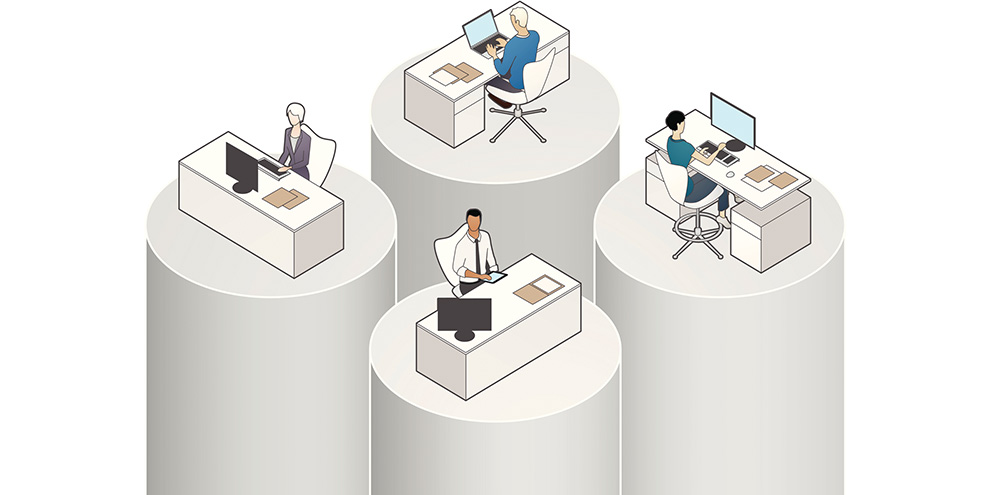Breaking down barriers
In the research and insights industry, we’ve often heard the warning cry of “information silos” – but what does this actually mean in the context of data collection? And how can we break down the silos once they are created?
In essence, data silos exist when multiple people or groups within an organization are collecting and storing information separately from each other, without then synthesizing this information for use and reference by the whole. If insights teams want to effectively guide business decisions, they must be able to operate and communicate with cohesive sets of data.
Data often enters an organization from all sides – and it may be that this cannot be modified, or at least it can’t be changed to the extent that data enters through a single source. That may just be the nature of an organization’s dynamic needs. But what can and should be modified is the way data is stored and communicated. When information enters through different channels without a single home, it loses so much of its potential to drive valuable insight, simply because it can’t easily be shared among all relevant parties in an organization. It’s a bit like buying cellphones for your family and never exchanging phone numbers. The infrastructure is there, but a critical piece is missing.
A data-driven culture
The reward for breaking down data silos is a culture of decision-making that is data-driven. An organization can have vast quantities of valuable data, but unless it is accessible and cohesively communicated, it can’t be accounted for when crucial decisions are made. According to a 2018 Quirk’s Article by former Forsta director of CX consulting, Roberta O’Keith, despite the explosion of data that has come with ever-increasing CX and data collection solutions,
- “54 percent of decision makers don’t have the data they need to guide strategic business decisions;
- 44 percent of decision makers say that organizational information silos are the biggest challenge preventing them from using data effectively; and
- only 4 percent of companies say they have the right people, tools and data to draw meaningful insights – and act on them.”
So where does the breakdown occur? A prime example according to O’Keith is an organization in which different departments are surveying customers for feedback on issues that are specific to those departments, triggering survey fatigue in customers who feel that their feedback is not being adequately taken into account (how could it be?) and creating vast quantities of redundant or inaccessible data.
“[Data silos] make it impossible to consolidate feedback for an organization to get a clear, holistic view of the customer experience,” says O’Keith. “They impede the ability to take effective action, and successfully closing the loop becomes nearly impossible. This challenge tends to be self-perpetuating and means that improving the customer experience remains a distant reality.”
When data is trapped in disparate parts, trying to utilize it involves wasting time manually pulling information together and potentially missing valuable insights in the process. O’Keith suggests three powerful steps for preventing data from becoming trapped in silos and correcting the problem when it occurs.
Make your strategy and goals clear.
Reworking data collection strategies and breaking down data silos is an ongoing process. Buy-in from stakeholders and decision makers is critical and requires setting clear expectations for the work involved and the intended outcome.
Stay flexible.
Business objectives change over time, and that means you may need to readjust goals from time to time. When reworking the data collection process, a clear goal is important upfront, but staying flexible and occasionally auditing the collection process is a must.
Embrace the audit.
Before delving into another data collection project, be prepared to conduct an audit to ensure that your survey is asking the right questions to get the right data – without duplicating existing efforts and lines of questioning.
Finding action in insight
So, you’ve revamped your data collection process and broken down the siloes that have left you and your respondents feeling fatigued – now what? Unfortunately, having ready access to data doesn’t necessarily ensure that it gets used to make important decisions. Rob Volpe, founder of Ignite 360, writes in a 2019 Quirk’s article that it isn’t enough to simply create insight; for data to be utilized by decision makers, we must create action too. Volpe suggests reimagining the final report share-out as something more dynamic than a presentation – something like an application workshop. “You have to go beyond reporting, past presenting and into facilitating conversation with the client team,” Volpe says.
Volpe outlines four tips generated from application workshops that he’s facilitated:
- Have a clear goal and agenda for the conversation, including key takeaways and recommendations for discussion. Reserve time to discuss any ideas that arise over the course of the workshop.
- Let participants visualize how these insights will be applied to their role within the organization, and allow time to discuss answers to this question.
- Create space for sharing ideas, and be careful not to stifle creativity through judgement, real or perceived. Encourage sharing active thinking, not just finished thoughts.
- At the end of the workshop, ensure the ideas created are given life by assigning them to individuals for execution and follow-up.
A better path to decision-making
Marketing research and insights as a field was created so that actual data could drive decision-making. But as organizations grow and channels for collecting insights multiply, companies are at risk of allowing their data collection process to fall to disparate pieces, trapping data within silos, creating redundant work, exhausting respondents and losing valuable insights that could drive decision-making forward. What’s more – siloed data creates an extra step of slow, manual work for insights teams that keep them from doing the work where their skills are most needed.
By breaking down silos and revamping the data collection process, organizations can save time and effort, uncover critical insights and develop business strategies that are data-driven.
